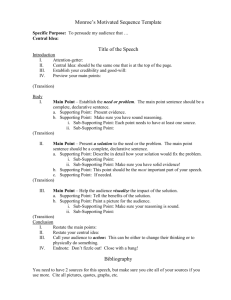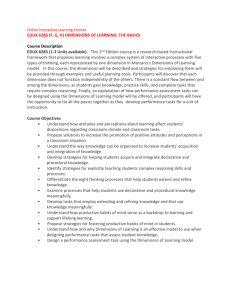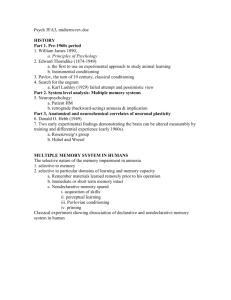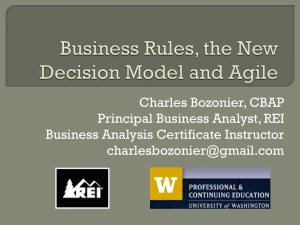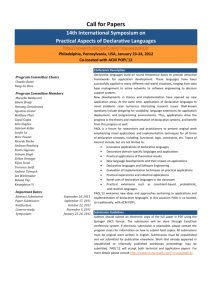Knowledge Representation and Organization
advertisement
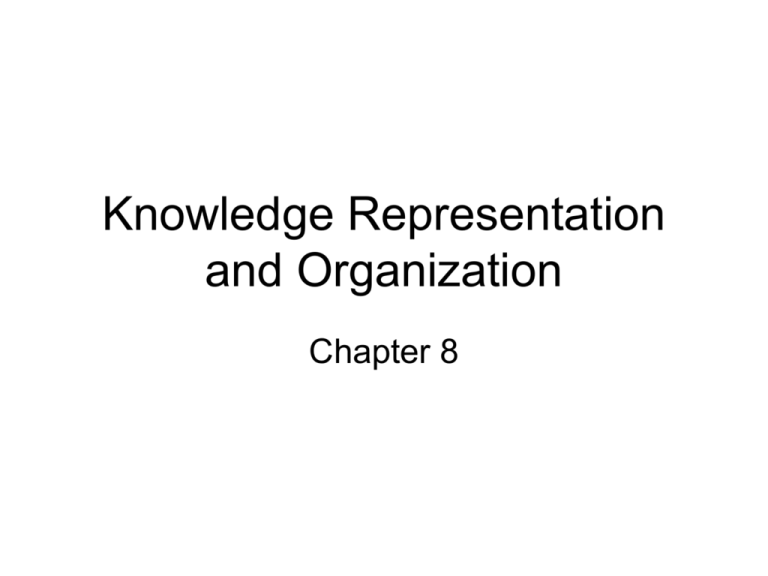
Knowledge Representation and Organization Chapter 8 Outline 1. Organization of Declarative Knowledge 1. Concepts and Categories 2. Semantic Network Models 3. Schematic Representations 2. Representations of Procedural Knowledge 3. Integrative Models for Representing Declarative and Nondeclarative Knowledge 1. Combining Representations: ACT-R 2. Models Based on the Human Brain 3. Parallel Processing: The Connectionist Model ? As quickly and as legibly as possible, write your normal signature, from the first letter of your first name to the last letter of your last name. Now as quickly and as legibly as possible, write your signature backward. Which signature was more easily and accurately created? Procedural Knowledge versus Declarative Knowledge • Declarative Knowledge – The what of knowledge representations • Procedural Knowledge – Involves some degree of skill, which increases as a result of practice – The how (the process) of knowledge representation • Previous slide – For both signatures, you had available extensive declarative knowledge of which letters precede or followed one another, but for the first task, you also could call on procedural knowledge, based on years of knowing how to sign your name 1. Organization of Declarative Knowledge • 1. Concepts and Categories Concept – – – • Fundamental unit of symbolic knowledge An idea about something that provides a means for understanding the world Often a single concept may be captured in a single word Category – – One way to organize concepts Functions to organize or point out aspects of equivalence among other concepts based on common features or similarity to a prototype 1. Organization of Declarative Knowledge • 1. Concepts and Categories Feature-Based Categories: A Defining View – – Classic view of conceptual knowledge involves disassembling a concept into a set of featural components, which are singly necessary and jointly sufficient to define the category Defining features constitute the definition of a category, according to the feature-based, componential point of view • • – a defining feature is a necessary one: For a think to be an “X”, it must have that feature E.g. Bachelor has defining features: male, unmarried, adult This theory can not capture typicality within categories (e.g. robin versus penguin) 1. Organization of Declarative Knowledge • 1. Concepts and Categories Prototype Theory: A Characteristic View – • Suggests that categories are formed on the basis of characteristic features, which describe the typical model of the category A prototype – – The original item on which subsequent models are based Model that best represents the class on which the category is based 1. Organization of Declarative Knowledge • 1. Concepts and Categories Prototype Theory: A Characteristic View – Characteristic features • • • Whereas a defining feature is possessed by every instance of a category, a characteristic feature need not be Many or most instances possess each characteristic features e.g. the ability to fly is typical of birds, but it is not a defining feature of a bird (ostrich can not fly) 1. Organization of Declarative Knowledge • 1. Concepts and categories Prototype Theory: A Characteristic View – Two kinds of categories: Classical concepts • • Categories that can be readily defined through defining features, such as bachelor Inventions that experts have devised for labeling a class Fuzzy concepts • • Categories that cannot be so easily defined, largely because the borders of what constitutes them are fuzzy Tend to evolve naturally (e.g. fruit) ? Divide the following items into the category of fruits and the category of vegetables: apples, carrots, tomatoes, cauliflower, oranges, pumpkin, cucumber 1. Organization of Declarative Knowledge • 2. Semantic Network Models Knowledge is represented in terms of a hierarchical semantic network – A web of interconnected elements consisting of • • Nodes - The elements representing concepts Labeled relationships which might involve category membership, attributes, or some other semantic relationship 1. Organization of Declarative Knowledge • 2. Semantic Network Models Concepts appear to have a basic level of specificity within a hierarchy that is preferred to other levels (Eleanor Rosh, 1978) – – – The basic level is neither the most abstract nor the most specific (e.g. apple) The basic level can be manipulated by context and expertise Basic level is the one that has the largest number of distinctive features, which set it off from other concepts at the same level 1. Organization of Declarative Knowledge • 3. Schematic Representations Schemas – A mental framework organizing knowledge, creating a meaningful structure of related concepts – Explain who concepts are related in the mind – E.g. kitchen 1. Organization of Declarative Knowledge • 3. Schematic Representations Scripts – – A structure that describes appropriate sequences of events in a particular context Scripts include default values for the actors, the props, the setting, and the sequence of events • E.g. the restaurant script – – – – – Props – tables, a menu, a food Roles to be played – a customer, a waiter, a cook Opening conditions for the script – the customer is hungry and has money Scenes – entering, ordering, eating, exhibiting Results – customer has less money, the owner has more money 2. Representations of Procedural Knowledge • Procedural knowledge can be organized in the form of sets of rules governing a production (generation and output of a procedure) • These rules are organized into – Routines • Instructions regarding procedures for implementing a task – Subroutines • Instructions for implementing a subtask within a larger task governed by a routine 2. Representations of Procedural Knowledge • Production system – comprises the entire set of rules for executing the task or using the skill – E.g. a production system for a pedestrian to cross the street at an intersection with a traffic light • Traffic-light red stop • Traffic-light green move • Move and left foot on pavement step with right foot • Move and right foot on pavement step with left foot 3. Integrative Models for Representing Declarative and Nondeclarative Knowledge • Combining Representations: ACT-R (Anderson) – Adaptive control of thought model of knowledge representation and information processing – A model of information processing that integrates a network representation for declarative knowledge and a production-system representation for procedural knowledge – Declarative network includes storing and retrieving of information; Procedural system implements the processes of proceduralization (automatization) 3. Integrative Models for Representing Declarative and Nondeclarative Knowledge • Models based on human brain – Nondeclarative knowledge may encompass a broader range of mental representation than just procedural knowledge • • • • Perceptual, motor, and cognitive skills Simple associative knowledge (conditioning) Simple nonassociative knowledge (habituation) priming 3. Integrative Models for Representing Declarative and Nondeclarative Knowledge • Models based on human brain – Amnesic patients: • Patient who is given repeated practice in reading mirror writing will improve as a result of practice but will not recall ever having engaged in practice • As your explicit access to nondeclarative knowledge decreases, your speed and ease of gaining implicit access to that knowledge increases 3. Integrative Models for Representing Declarative and Nondeclarative Knowledge • Parallel Processing: The connectionist model – Parallel processing – multiple operations go on all at once – Parallel distributed processing (PDP) models or connectionist models • We may be able to process information as efficiently as we do because we can handle very large numbers of cognitive operations at once through a distributed network 3. Integrative Models for Representing Declarative and Nondeclarative Knowledge • Parallel Processing: The connectionist model – Networks consist of nodes and connections between them – The more often a particular connection is activated, the greater is the strength of the connection – The basic aspect of these models is learning 3. Integrative Models for Representing Declarative and Nondeclarative Knowledge • Domain general versus Domain specific systems – Domain general • The same mental processes underlie various cognitive tasks – Domain specific • There are specific mental processes underlying various cognitive tasks

